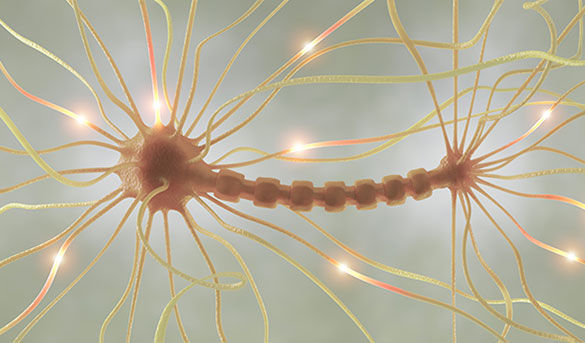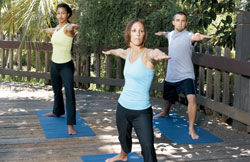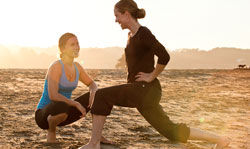
Working with clients one-on-one or in small groups provides the perfect setting for you to do more than just aerobicize and pump them up. Provide them with a more holistic approach to fitness and you’ll not only bring some calm to their hectic lives, but you could also add more value to your bottom line.
This holistic approach to fitness begins with the vagus nerve. If you’ve never explored the role the vagus nerve has in your body, you’re going to be amazed and wonder why you didn’t know this already.
Trust Your Gut
“Getting on my nerves” takes on new meaning when you’re referring to the vagus nerve (VN). This busy, wandering (vagus means “wandering” in Latin) nerve is the captain of the parasympathetic nervous system (PSNS), which is part of the autonomic nervous system. The VN is rooted in your brain stem and cerebellum and literally wanders down your body, breaking off into multiple branches that go all the way down to your lowest viscera, touching nearly every major organ in your body along the way. When you say you have a “gut feeling,” you are literally referring to your vagus nerve, as it is responsible for transferring emotions and the state of your viscera to your brain.
The PSNS is responsible for producing a calming effect in your body by lowering heart rate, and triggers the release of acetylcholine, your body’s natural tranquilizer. The VN is also known as the “rest-and-digest” and “feed-and-breed” nerve, as it stimulates these types of activities, including rest and sleep, digestion and sexual arousal.
Vagus nerve stimulation (VNS) has been shown to have many health benefits. For example, researchers from Boston University School of Medicine (BUSM), New York Medical College, and the Columbia College of Physicians and Surgeons reviewed evidence that shows that yoga may be effective in treating patients with stress-related psychological and medical conditions, including depression, anxiety, high blood pressure and cardiac disease.
How they think it works is that stress causes an imbalance in the autonomic nervous system, as well as under-activity of gamma amino-butyric acid (GABA), an inhibitory neurotransmitter. Low GABA levels occur in anxiety disorders, post-traumatic stress disorder, depression, epilepsy and chronic pain. Researchers hypothesize that stimulating the vagus nerve increases GABA levels and could explain why VNS works to decrease both seizure frequency, as well as the symptoms of depression.
Earlier studies done by BSMU researchers showed that individuals who did yoga increased their GABA levels while decreasing symptoms of anxiety, whereas study participants who were part of the walking group showed no increase in GABA levels. A second study done with patients with chronic low-back pain showed the group who received yoga intervention responded with increased GABA levels and a significant reduction in pain when compared to the group who received only standard care.
Researchers at the University of North Carolina at Chapel Hill found that high vagal tone was part of a feedback loop between positive emotions, physical health and positive social connections. Healthy vagal tone is indicated by an increase in heart rate when you inhale and a decrease in heart rate when you exhale.
Other studies have shown that implanted VNS devices can be used for epilepsy and to decrease the pain and inflammation of rheumatoid arthritis.
What Does All This Mean for You?
It obviously isn’t practical for everyone to have an implantable VNS device, but there are some very practical things anyone—including both you and your clients—can do to stimulate this amazing nerve.

“Breathing techniques and certain lifestyle habits that incorporate breathing exercises, such as yoga and meditation, are great ways to stimulate the vagus nerve naturally,” says Ilan Danan, MD, neurologist at the Kerlan-Jobe Center for Sports Neurology and Pain Medicine at Kerlan-Jobe Orthopaedic Clinic in Los Angeles, Calif. “Other things that individuals do daily, whether they know it or not, act to stimulate the vagus nerve, as well. This includes acts, such as laughing or singing, which act to increase heart rate variability, resulting in vagus nerve stimulation.”
Danan reiterates the VN’s health benefits. “It is believed that routine VNS may have varied positive effects on the body, both physiologically and behaviorally. From an emotional perspective, it is said to help those suffering from depression, anxiety and PTSD. Physiologically, its activation maintains gastrointestinal health and is also believed to help in minimizing inflammation.”
Both Sue Hitzmann, author of The MELT Method: A Breakthrough Self-Treatment System to Eliminate Chronic Pain, Erase the Signs of Aging, and Feel Fantastic in Just 10 Minutes a Day and creator of the MELT Method, and Jill Miller, author of The Roll Model: A Step-by-Step Guide to Erase Pain, Improve Mobility and Live Better in Your Body and creator of Yoga Tune Up, are very familiar with VNS and have created programs around it. Here they offer a couple of their favorite VNS exercises you can use yourself and with clients.
3-D Breath Breakdown
Alter heart rate variability and increase vagal tone using what Hitzmann calls the 3-D Breath Breakdown. (detailed instructions on how to perform this breath sequence can be found here). “This is so simple to do,” Alter says. “It directly increases heart-rate variability and allows a person to control a key element of the autonomic nervous system through this clever diaphragmatic technique. By slowing down and focusing on the direction of the diaphragmatic motion, you alter the way the brainstem signals the diaphragm to contract as it does some 25,000 times a day when you breathe and don’t think about it.”
50-second Facelift
“The jaw is related to both the trigeminal and vagus nerve,” explains Hitzmann, “and often misalignment of the jaw can cause low vagal tone. If you have had braces or lots of mouth work, or have unstable hips and poor foot strength and integrity, you are at risk for low vagal tone. By stimulating the tissue where the vagus nerve branches out behind the ears, you can decrease the compression the tissue often has at the base of the skull. This is often a culprit of vagal issues missed in treatment. Sometimes the nerve is actually fine, yet the tissue surrounding it causes imbalances in its connection from brain to gut. By releasing the tissues in this area with the 50-second Facelift technique, you can quickly boost the balance and connection the vagus nerve needs to function efficiently.”
Gentle Inversions
“Go upside-down(ish) to lighten up,” says Miller. “Prop yourself so that your pelvis and heart are slightly higher than your head. excites the pressure sensors—the baroreceptors—on the side of the neck within the carotid arteries. They relay messages directly to the vagus nerve, which responds by constricting all blood vessels and slowing down the breath rate. The end result? It slows down sympathetic output and hastens parasympathetic dominance.”
Supra-Clavicle Release (aka Neck Gnar)
“Your lateral anterior neck is loaded with pressure points where your vagus nerve can be manually massaged,” explains Miller. “You won't need a lot of pressure to stimulate the relaxation response. Try the standing technique to massage into the scalenes that overlay your vagus and feel your whole day become new again.”
Today’s clientele is looking beyond the barbells and wants a holistic approach that serves them in ways traditional fitness may not. Begin incorporating these techniques for a well-rounded approach to your clients’ fitness programs.





 by
by 







